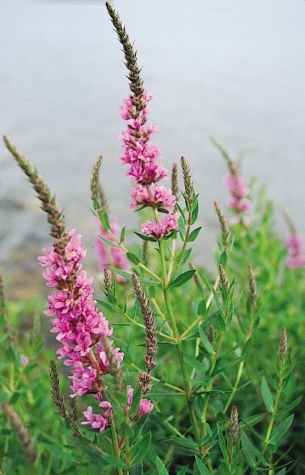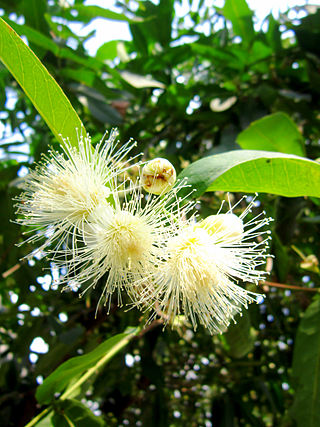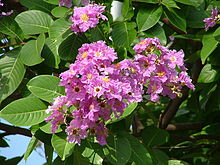
The jackfruit is a species of tree in the fig, mulberry, and breadfruit family (Moraceae). The jackfruit is the largest tree fruit, reaching as much as 55 kg in weight, 90 cm in length, and 50 cm in diameter. A mature jackfruit tree produces some 200 fruits per year, with older trees bearing up to 500 fruits in a year. The jackfruit is a multiple fruit composed of hundreds to thousands of individual flowers, and the fleshy petals of the unripe fruit are eaten.

Lythraceae is a family of flowering plants, including 32 genera, with about 620 species of herbs, shrubs, and trees. The larger genera include Cuphea, Lagerstroemia (56), Nesaea (50), Rotala (45), and Lythrum (35). It also includes the members of the former families of the pomegranate and of the water caltrop. Lythraceae has a worldwide distribution, with most species in the tropics, but ranging into temperate climate regions as well.

Lagerstroemia, commonly known as crape myrtle, is a genus of around 50 species of deciduous and evergreen trees and shrubs native to the Indian subcontinent, southeast Asia, northern Australia, and other parts of Oceania, cultivated in warmer climates around the world. It is a member of the family Lythraceae, which is also known as the loosestrife family. These flowering trees are beautifully colored and are often planted both privately and commercially as ornamentals.

Saraca asoca, commonly known as the ashoka tree, is a plant belonging to the Detarioideae subfamily of the legume family. It is an important tree in the cultural traditions of the Indian subcontinent and adjacent areas. It is sometimes incorrectly known as Saraca indica. The flower of ashoka tree is the state flower of Indian state of Odisha.

Chaenomeles is a genus of four species of deciduous spiny shrubs, usually 1–3 m tall, in the family Rosaceae. They are native to Southeast Asia. These plants are related to the quince and the Chinese quince, differing in the serrated leaves that lack fuzz, and in the flowers, borne in clusters, having deciduous sepals and styles that are connate at the base.

Syzygium samarangense is a species of flowering plant in the family Myrtaceae, native to an area that includes the Greater Sunda Islands, Malay Peninsula, and the Andaman and Nicobar Islands, but introduced in prehistoric times to a wider area and now widely cultivated in the tropics. Common names in English include wax apple, Java apple, Semarang rose-apple, and wax jambu.
Pride of India or Pride-of-India is a common name for several plants and may refer to:

Cassia fistula, also known as golden shower, purging cassia, Indian laburnum, kani konna, or pudding-pipe tree, is a flowering plant in the family Fabaceae. The species is native to the Indian subcontinent and adjacent regions of Southeast Asia. It is the official state flower of Kerala state and Delhi UT in India. It is also a popular ornamental plant and is also used in herbal medicine.

Catalpa speciosa, commonly known as the northern catalpa, hardy catalpa, western catalpa, cigar tree or catawba, is a species of Catalpa native to the midwestern United States.

Kigelia is a genus of flowering plants in the family Bignoniaceae. The genus consists of only one species, Kigelia africana, which occurs throughout tropical Africa. The so-called sausage tree grows a poisonous fruit that is up to 60 cm long, weighs about 7 kg, and resembles a sausage in a casing.

Lagerstroemia indica, commonly known as a crape myrtle, is a species of flowering plant in the genus Lagerstroemia of the family Lythraceae. It originated in China. It is an often multi-stemmed, deciduous tree with a wide spreading, flat topped, rounded, or even spike shaped open habit. The tree is a popular nesting shrub for songbirds and wrens.

Cheilocostus speciosus, or crêpe ginger, is a species of flowering plant in the family Costaceae. Some botanists have now revived the synonym Hellenia speciosa for this species.

Lagerstroemia subcostata, the Taiwan crepe myrtle, is a deciduous tree native to Japan, the Ryukyu Islands, Taiwan, and southern China, and introduced to the Philippines.

Phoenix sylvestris also known as silver date palm, Indian date, sugar date palm or wild date palm, is a species of flowering plant in the palm family native to southern Pakistan, most of India, Nepal, Bhutan, Myanmar and Bangladesh. It has been introduced to southeastern China, Sri Lanka, Mauritius, Puerto Rico and the Leeward Islands. Growing in plains and scrubland up to 1300 m above sea level, the fruit from this palm species is used to make wine and jelly. The sap is tapped and drunk fresh or fermented into toddy. The fresh sap is boiled to make palm jaggery in West Bengal state of India and Bangladesh.

Lagerstroemia floribunda, also known as Thai crape myrtle and kedah bungor, is a species of flowering plant in the family Lythraceae. It is native of the tropical region of Southeast Asia.

Lagerstroemia calyculata known as the "Guava Crape Myrtle" ; the name is derived from its very characteristic mottled flaky bark. It is a species of flowering plant in the family Lythraceae and found in Southeast Asia and Oceania.

Sterculia foetida is a soft wooded tree that can grow up to 35 metres tall. Common names for the plant are the bastard poon tree, Java olive tree, hazel sterculia, wild almond tree, and skunk tree.

Calophyllum polyanthum is a species of flowering plant belonging to the genus Calophyllum of the family Calophyllaceae, commonly known as the poonspar tree, sirpoon tree, punnapine, pinnapai, punnappine, kattupunna and malampunna. This tree is native to the Western Ghats in India, where it grows in abundance there. It is also found in Andaman & Nicobar Island, Bangladesh, Bhutan, Laos, Myanmar, Thailand and Vietnam.

Lagerstroemia micrantha is a species of crepe myrtle in the family Lythraceae. It is a shrub or small tree native to southern Vietnam. Lagerstroemia micrantha lives in wet, tropical areas. The flowers of Lagerstroemia micrantha bloom in the late summer to early fall. Lagerstroemia micrantha prefers loose soil.

Lagerstroemia × egolfii, the hybrid crape myrtle, is an artificial hybrid species of flowering plant in the family Lythraceae. Its parents are Lagerstroemia indica and L. subcostata var. fauriei.




























